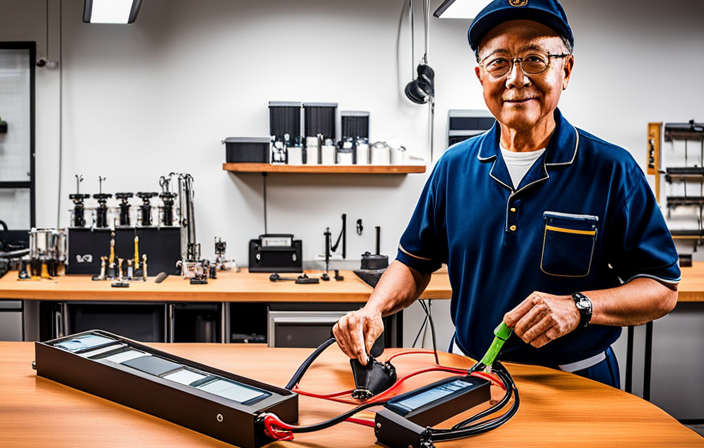As an avid cyclist and DIY enthusiast, I’ve always been fascinated by the inner workings of electric bikes. Building my own battery pack was like unlocking the hidden power within my two-wheeled companion.
In this article, I’ll guide you through the process of creating a customized battery for your electric bike, step by step. From understanding the basics to troubleshooting common issues, we’ll delve into the technical details to ensure you have a reliable and efficient power source for your next ride.
Let’s get started.
Key Takeaways
- Select durable, lightweight, and moisture-resistant materials for the battery and enclosure.
- Incorporate proper ventilation and protection in the enclosure to prevent overheating and maximize battery efficiency.
- Securely connect the battery to the bike using the appropriate tools and techniques for efficient operation and longevity.
- Follow proper charging, maintenance, and disposal protocols to ensure optimal performance, safety, and longevity of the battery.
Understanding Battery Basics
Understanding the basics of batteries is crucial when it comes to making a battery for an electric bike. Battery chemistry plays a significant role in determining the performance and lifespan of the battery. Different types of batteries, such as lithium-ion or lead-acid, have varying chemistries that affect their capacity, energy density, and charging capabilities.
It is important to choose the right battery chemistry for an electric bike based on its power requirements and desired range. Additionally, understanding charging methods is essential to ensure the longevity of the battery. Proper charging techniques, such as using the correct voltage and current levels, can prevent overcharging or undercharging, which can degrade the battery over time.
Gathering the Necessary Materials
First, you’ll need to gather all the materials needed for the project. Here’s what you’ll need to get started:
-
Selecting battery cells: Choose high-quality lithium-ion battery cells that are suitable for your electric bike. Consider factors such as capacity, voltage, and discharge rate.
-
Testing battery capacity: Make sure to have a battery capacity tester to accurately measure the capacity of your battery cells. This will help you determine the overall capacity of your battery pack.
-
Battery management system (BMS): A BMS is crucial for monitoring and balancing the cells in your battery pack. It protects against overcharging, over-discharging, and overheating.
-
Battery enclosure: To ensure safety and protection, you’ll need a sturdy and properly designed battery enclosure to house your battery pack.
Once you have gathered all these materials, you are ready to move on to planning your battery design, ensuring optimal performance and safety for your electric bike.
Planning Your Battery Design
Now that you’ve gathered all the necessary materials, it’s time to carefully plan the design of your battery for optimal performance and safety.
The first step in planning your battery design is to determine the battery capacity you will need. This is calculated by considering factors such as the distance you want to travel on a single charge and the power requirements of your electric bike.
Once you have determined the battery capacity, you can move on to determining the voltage requirements. This involves considering the voltage rating of your electric bike’s motor and any other electrical components that will be powered by the battery.
By carefully considering both the battery capacity and voltage requirements, you can design a battery that will provide sufficient power and ensure the safe operation of your electric bike.
With the design plan in place, we can now move on to assembling the battery pack.
Assembling the Battery Pack
When it comes to assembling the battery pack, it’s crucial to properly align and connect the battery cells. This ensures that the cells are arranged in a way that maximizes efficiency and minimizes the risk of damage.
Additionally, it’s essential to ensure secure and insulated connections to prevent any potential short circuits or electrical hazards. This involves using appropriate connectors and insulating materials to guarantee a safe and reliable battery pack.
Properly aligning and connecting the battery cells
To properly align and connect the battery cells, make sure you carefully match the positive and negative terminals. This is crucial for the overall performance and longevity of the battery pack.
Start by arranging the cells in the desired configuration, ensuring that the positive and negative terminals are aligned correctly. Once the cells are in place, use a spot welder or soldering iron to connect the terminals securely. This will create a strong and stable connection between the cells.
It is important to be precise and meticulous during this process, as any misalignment or loose connection can lead to inefficiency or even potential safety hazards.
By ensuring proper battery cell alignment and connection, you are laying the foundation for a reliable and efficient battery pack.
Now, let’s move on to the next step of ensuring secure and insulated connections.
Ensuring secure and insulated connections
To ensure secure and insulated connections, it’s important to carefully seal any exposed terminals with electrical tape. This step is crucial in preventing any accidental short circuits or electrical shocks.
In addition to using electrical tape, there are other insulating techniques and secure connection methods that can be employed when building a battery for an electric bike.
One effective technique is to use heat shrink tubing. This provides a durable and tight seal around the terminals, protecting them from moisture and other external factors.
Another method is to use silicone sealant, which creates a waterproof barrier and adds an extra layer of insulation. Additionally, using terminal connectors with built-in insulation can further enhance the overall security and insulation of the connections.
By implementing these insulating techniques and secure connection methods, you can ensure that your battery is well-protected and reliable.
Now, let’s explore the next step of adding a battery management system (BMS) to further enhance the performance and safety of your electric bike setup.
Adding a Battery Management System (BMS)
Adding a BMS is crucial for monitoring and protecting the battery of an electric bike. A Battery Management System (BMS) is responsible for ensuring battery safety and optimizing performance. It acts as the brain of the battery, constantly monitoring its voltage, current, and temperature. By doing so, it prevents overcharging, overdischarging, and overheating, which can lead to battery damage or even fire hazards.
The BMS also balances the battery cells, ensuring that each cell is charged and discharged equally. This is important for maximizing the battery’s capacity and lifespan. Additionally, the BMS provides important diagnostic information, such as the state of charge and remaining battery capacity. With a BMS in place, you can have peace of mind knowing that your battery is being managed and protected effectively.
Now, let’s move on to building a battery enclosure.
Building a Battery Enclosure
When building a battery enclosure, it’s crucial to choose the right materials to ensure the safety and longevity of the battery. Materials such as ABS plastic or aluminum are commonly used due to their durability and resistance to corrosion.
Additionally, proper ventilation must be considered to prevent overheating and ensure optimal performance of the battery.
Lastly, protection from the elements, such as water and dust, should be incorporated into the design to safeguard the battery from potential damage.
Choosing the right materials for the enclosure
The first step in choosing the right materials for the enclosure is figuring out the size and dimensions needed. The size of the enclosure will depend on the size of the battery and other components that need to be housed inside. It is crucial to choose the right size to ensure a proper fit and protection for the battery.
Once the size is determined, selecting the appropriate materials is the next important consideration. The materials should be durable, lightweight, and resistant to moisture and impact. Common materials used for battery enclosures include aluminum, steel, and plastic composites. These materials provide excellent protection and are easy to work with.
Transitioning into the next section, it is also important to ensure proper ventilation and protection from the elements to maintain the battery’s performance and longevity.
Ensuring proper ventilation and protection from elements
To maintain the battery’s performance and longevity, it’s important to ensure proper ventilation and protection from the elements. Ventilation techniques play a crucial role in preventing overheating and extending the battery’s lifespan.
One method is to incorporate vents or perforations in the battery enclosure, allowing for air circulation and heat dissipation. This ensures that the battery remains at an optimum temperature during operation.
Additionally, weatherproofing methods are essential to shield the battery from rain, snow, and other environmental factors. Applying a waterproof coating or using a sealed enclosure can provide effective protection.
By implementing these ventilation techniques and weatherproofing methods, you can safeguard your battery and maximize its efficiency.
Now, let’s explore how to connect the battery to your electric bike.
Connecting the Battery to Your Electric Bike
You’ll need a wrench to securely attach the battery to your electric bike. Properly connecting the battery is crucial for efficient operation and to ensure its longevity.
Start by locating the battery compartment on your bike, usually located near the frame or under the seat. Carefully align the battery with the connectors in the compartment, making sure they match. Use the wrench to tighten the bolts and secure the battery in place.
Once attached, you can move on to the next step, which involves charging and maintaining your battery to maximize its performance and extend its capacity. By following the proper battery maintenance techniques, you can ensure that your electric bike remains powered and ready for your next adventure without any hiccups.
Charging and Maintaining Your Battery
Start by regularly checking the charge level of your battery to ensure optimal performance and longevity. Proper battery maintenance is crucial for extending the battery lifespan of your electric bike. To start, always charge your battery fully before each ride. This ensures that you have enough power to reach your destination without straining the battery. Avoid overcharging your battery as it can lead to decreased performance and even damage. Additionally, it’s important to store your battery in a cool, dry place when not in use. Extreme temperatures can negatively impact the battery’s performance and lifespan. By following these battery maintenance tips, you can maximize the lifespan of your battery and enjoy long rides on your electric bike.
Now, let’s move on to safety precautions and considerations when using your electric bike.
Safety Precautions and Considerations
When it comes to handling and disposing of batteries safely, there are a few key precautions to keep in mind.
First, it is important to always handle batteries with care, avoiding any rough handling or dropping them which could lead to leakage or damage.
Additionally, when it comes time to dispose of batteries, it is crucial to follow proper protocols and guidelines to prevent environmental harm.
Moving on to protecting against overcharging and overheating, it is essential to use chargers specifically designed for the type of battery being used, as well as to never leave batteries unattended while charging.
Implementing these safety measures will help ensure the longevity and safe use of batteries.
Handling and disposing of batteries safely
Be sure to handle and dispose of your batteries safely to prevent any potential harm. Proper battery storage and disposal is crucial for both personal safety and environmental protection.
When it comes to battery storage, it is important to keep them in a cool, dry place away from direct sunlight or extreme temperatures. Avoid storing batteries near flammable materials and always keep them out of reach of children.
When it comes to disposing of batteries, it is essential to follow local regulations and guidelines. Many communities have designated drop-off locations or recycling programs for batteries. This ensures that they are properly handled and recycled, preventing harmful chemicals from ending up in landfills.
By taking these precautions, you can minimize the risk of accidents and contribute to a cleaner environment.
Moving on to the next section, it is important to also protect against overcharging and overheating to maximize battery lifespan.
Protecting against overcharging and overheating
To prevent damage, it’s important to monitor and control the charging process of your batteries. This is crucial in preventing battery degradation and ensuring optimal performance.
One way to achieve this is by regularly checking the voltage and temperature of the battery during charging. Use a reliable battery management system (BMS) to monitor these parameters accurately. The BMS will also help prevent overcharging by automatically cutting off the charging process once the battery reaches its maximum capacity.
Additionally, it’s essential to use a charger specifically designed for your battery type to avoid overheating. By carefully monitoring and controlling the charging process, you can prolong the lifespan of your battery and maintain its performance.
Now, let’s move on to troubleshooting common battery issues without delay.
Troubleshooting Common Battery Issues
One common battery issue is that it won’t hold a charge for very long. This can be frustrating, especially if you rely on your battery for everyday use. To troubleshoot this issue, it’s important to understand the factors that can contribute to a battery’s degradation. Regular battery maintenance is essential in preventing battery degradation. Here are some tips to help you maintain your battery’s performance and prolong its lifespan:
-
Keep your battery at the appropriate temperature: Extreme temperatures can negatively impact battery performance. Avoid exposing your battery to excessive heat or cold.
-
Avoid overcharging: Overcharging can lead to battery damage and reduce its overall capacity. Make sure to unplug your battery once it’s fully charged.
-
Store your battery properly: If you won’t be using your battery for an extended period, store it in a cool and dry place. Avoid storing it in extreme temperatures or direct sunlight.
By following these battery maintenance practices, you can prevent battery degradation and ensure your battery holds a charge for longer durations.
| Maintenance Tips | Description |
|---|---|
| Appropriate Temperature | Avoid exposing the battery to extreme heat or cold. |
| Avoid Overcharging | Unplug the battery once it’s fully charged to prevent damage. |
| Proper Storage | Store the battery in a cool and dry place, away from extreme temperatures or direct sunlight. |
Frequently Asked Questions
How long does it take to fully charge an electric bike battery?
It typically takes around 4-6 hours to fully charge an electric bike battery using optimal charging methods. It is important to follow the manufacturer’s guidelines to maintain battery life and ensure efficient charging.
Can I use any type of battery for my electric bike?
You should use a battery that is compatible with your electric bike. The best battery options are lithium-ion and lithium polymer batteries, which offer long-lasting power and high energy density for optimal performance.
What is the average lifespan of an electric bike battery?
The average lifespan of an electric bike battery depends on several factors. These include usage patterns, charging habits, temperature, and battery quality. Proper maintenance and regular electric bike battery replacement can extend its lifespan.
How do I know if my battery is fully charged?
To measure the battery capacity of my electric bike, I can use a battery capacity tester. It will provide accurate readings to determine the charge level. Overcharging the battery can lead to reduced lifespan and potential damage.
Are there any specific maintenance tasks I need to perform regularly on my electric bike battery?
To prolong battery life and ensure optimal performance, regular battery maintenance is crucial. This includes keeping the battery clean and dry, checking for any signs of damage or corrosion, and following the manufacturer’s guidelines for charging and storing the battery.
Conclusion
In conclusion, creating a battery for an electric bike requires a thorough understanding of battery basics and careful planning. By gathering the necessary materials and designing the battery pack, one can assemble a reliable power source.
Adding a Battery Management System ensures optimal performance and safety. Connecting the battery to the electric bike allows for a smooth ride, while proper charging and maintenance prolongs battery life.
It is crucial to prioritize safety precautions and be prepared to troubleshoot any potential issues. With these steps, you can embark on a euphoric journey with your electric bike.









